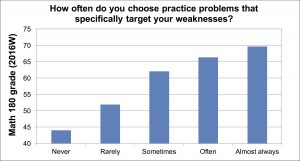Choosing practice problems
Work your way through a few practice problems until you feel confident about a topic, then move on to the next topic. Make sure you cover every type of question in the book for each section.
Anna – former Math 180 student
You will find that your first year math course offers you many sources of practice problems. Given all this choice, how do you choose which problems to work on? A basic guideline that can help you get the most out of your practice time is to choose practice problems that target your weaknesses.
In order to identify your weaknesses, look the old exams wiki or other sources of problems. Using these resources, group problems according to the techniques and concepts used, and test yourself on a problem from each group. For example, if you are practicing basic differentiation techniques, you could group problems according to the type of functions (polynomials, trig, logarithms, etc..) and the type of differentiation rule (product, quotient, chain, etc..).
In addition to targeting your weaknesses in calculus, you may also want to target any gaps in your pre-calculus skills and knowledge. The pre-calculus review site on connect.ubc.ca has a package called “Calculus-inspired review” which will list the pre-calculus topics which are most relevant to each calculus topic.
Surveys of Math 180 students in 2016 show that those who deliberately target their weaknesses more often tend to do better in the course (graph below).

Click on the graph for more detailed data and statistics. Data obtained using student surveys in Math 180 in 2016W at UBC. Research funded by the CWSEI and the Department of Mathematics.
Reproducing exam conditions
“I only did problems with my notes, taking as much time as I needed. Under time pressure and without notes to consult, I am able to better identify the concepts I need to work on.”
Bernadette – former Math 101 student
One of the keys to your preparation for an exam is to simulate the exam experience as much as possible. This means that when preparing for an exam or quiz, you should spend some of the time working under the following conditions:
- No books, notes or other aids (unless these are allowed on your test).
- No outside distractions (put away your computer).
- No calculator (unless they are allowed on your test).
- A realistic time limit for when you should complete the problems.
Working without your notes/books will quickly help you realize which formulas and concepts you still need to learn. Every time you encounter a difficulty remembering or applying a formula or concept, add it to a formula sheet. Review this formula sheet periodically until you have memorized and understood everything on it.
To determine a realistic time limit for solving a set of problems, look at the pdf file of the old exam, and determine how many marks was allotted to that question. By dividing that number of marks by the total number of marks on the exam, you can find out what time should be spent on that question (relative to the length of the exam).
Make sure that you solve a diverse set of problems in succession and without interruptions, as you would be required to do on an exam. This will give you practice budgeting your time among different problems.
The night before the exam or quiz, it is often tempting to stay up late in order to do more practice problems. At that point, however, the benefit of getting more sleep far outweighs any benefit from extra practice, and it is better to go to bed sooner than later. The wellness centre at UBC is a great place to drop by if you would like advice on getting enough sleep and staying healthy in general.
